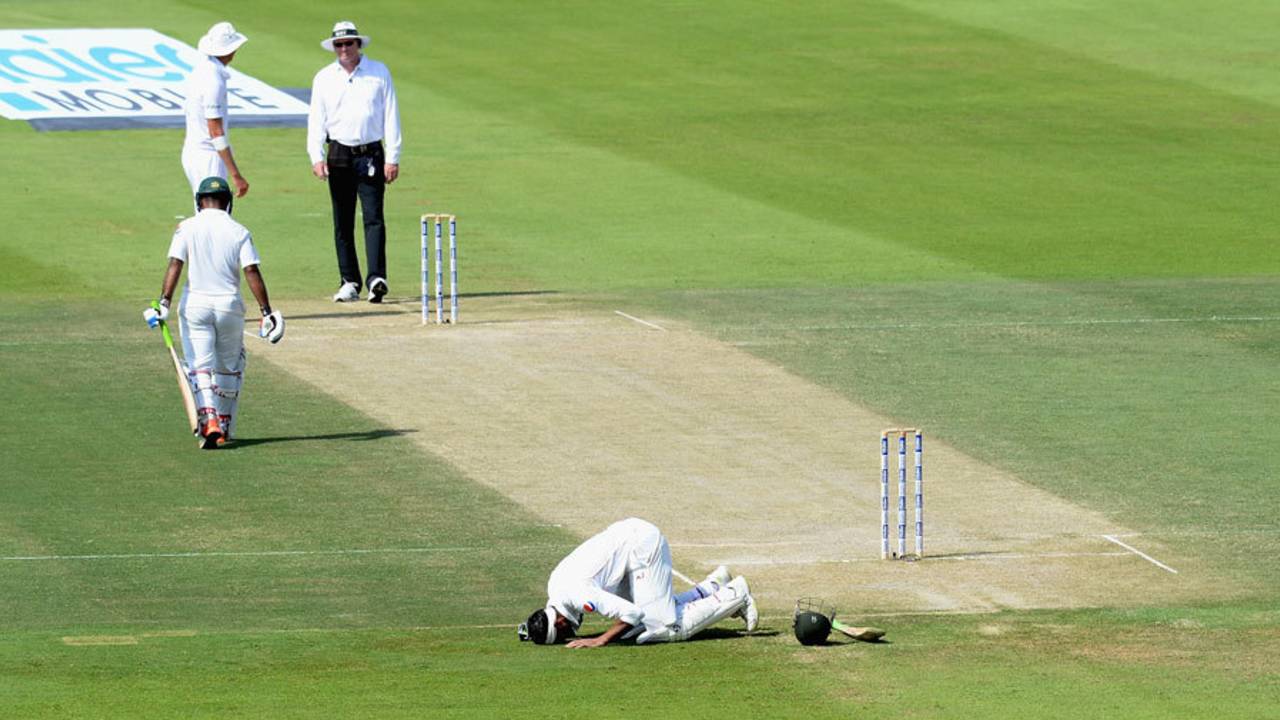'Ultra-edge', Hawk Eye's version of Snicko*, has been approved for use as part of the Decision Review System (DRS), according to
Geoff Allardice, the ICC's general manager of cricket, although the prospect of any uniformity over the application of the technology - and a long-term solution for who carries the cost - remains a long way off.
The 'Ultra-edge' system has been tested by engineers at the Massachusetts Institute of Technology (MIT) in Boston and gained a positive assessment. It is able to differentiate more clearly over sounds created by bat, pads or clothing, although Allardice said "ultimately we are still judging a sound and it will need interpretation as to what created that sound."
However, it is unlikely to be seen in all Test series, given that the poorer boards are unable to afford their share of the cost for the full DRS. Neither of the Test series taking place at the moment - Pakistan-England in the UAE and Sri Lanka-West Indies - has the full system available, both lacking Hot Spot and Snicko due to the cost burden on the home board of providing the systems in conjunction with the host broadcaster.
Two decisions in particular in Abu Dhabi would have had been given more clarity had either or both of those elements been available. Instead the third umpire, S Ravi, was left with only audio to use to adjudicate on nicks behind. In Pakistan's first innings
Misbah-ul-Haq was dismissed caught behind when the on-field not-out call was overturned. Then, in their second innings,
Mohammad Hafeez survived a tight decision having also been given not out caught behind off
Adil Rashid.
One solution to find uniformity on what is available would be for the ICC to centrally carry the cost of the DRS. When asked if this was an option,
David Richardson, the ICC chief executive, said: "Yes, but we need to get to the stage where everyone is using it.
"To me it's not such a big issue, whichever way you look at it cricket ends up paying for it. If the members are going to place it on the broadcasters to provide the technology then they may deduct the cost from what they pay the board. Ideally we want to get to the stage of consistent application."
The major stumbling block to that consistency remains the BCCI. There has been a hint of some thawing over the issue with Anil Kumble, who is chairman of the ICC cricket committee, slowly becoming a convert. He had initially been put off the system by his experience as a player during the first series it was trialled, between Sri Lanka and India in 2008, when there were a number of contentious decisions. Still, Richardson conceded the BCCI may never come around.
"Hopefully the BCCI will take heed when the cricket committee meet next May," he said. "The problem is they also have an objection from an 'in principle' point of view as well as doubts over accuracy. It's not guaranteed they will go down that route."
Meanwhile, there are no plans in the near future to implement a system in which the third umpire can intervene on the initial calling of no-balls after the umpires themselves said they wanted to retain the authority of watching the front-line in the middle.
Missed no-balls, an increasing occurrence at international level, were a feature of the first Test in Abu Dhabi. Stuart Broad was denied the wicket of Shoaib Malik when he overstepped - a decision confirmed by the TV umpire, not on-field - following an earlier no-ball which had not been called. Later, replays showed that Alastair Cook's 263 was ended by a no-ball when Shoaib Malik, in a more unusual occurrence, landed in front of the line before dragging his heel back.
Currently, third umpires are provided with split-screen replays from the square-on cameras which are locked on the popping crease. Within ten seconds they can see a replay of any delivery, but currently there is no protocol for them to intervene in a decision unless asked by the on-field official.
"We talked about it at length a few weeks ago and the view of the group is that they need to get better and be more decisive," Allardice said. "They weren't looking for a technology solution, it's part of their trade and they think they can do all better.
"It's not all umpires on all days, no-balls are called all over the world, but there are some missed - there have been from day dot, they are just being scrutinised a lot more. At the moment we aren't looking at a technology solution, but there are things being worked on behind the scenes."
Allardice confirmed that the instructions to umpires was only to call no-balls when they were certain. However, he insisted that the on-field officials, sometimes helped by information from the TV umpire, still communicated with bowlers to warn them when they were getting close to the line.
*9.30pm, October 19: The story was amended to correct reference of Hot Spot to Hawk Eye
Andrew McGlashan is a deputy editor at ESPNcricinfo
